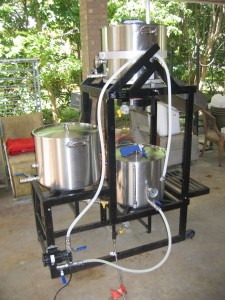
Shiny. My 10-gallon (38-L) brewing rig — a tippy dump sculpture made by MoreBeer. The three vessels — HLT, mash/lauter tun, and kettle — are made from 15-gallon (57-L) stainless steel pots.
More beer! Homebrewers who’ve been at it for a few years often heed this call and scale up from 5 gallons (19 L) to 10 gallons (38 L) or more. The fundamentals of brewing beer don’t change no matter what scale you’re brewing at. In addition, scaling from 5 gallons (19 L) to 10 gallons (38 L) requires no new skills — you just need a bigger set of vessels than your 5-gallon (19-L) brewery.
Scaling up to 10 gallons (around 40 L) has one big benefit — you yield twice the volume of beer while your brewday is roughly the same length. Depending on your equipment, it may take slightly longer to heat your water or chill your wort. However, with a brewery designed to to make 10 gallons (38 L) of wort per batch, the time spent brewing will be equivalent to brewing 5 gallons (19 L).
There are a few incidental benefits to scaling up. For instance, your mash volume is going to be larger, and consequently have a smaller surface-to-volume ratio. As such, it will require less insulation or periodic heating to keep the mash temperature steady.
On the other hand, there are some minor drawbacks that come with size. You’ll use more energy (likely in the form of propane) for heating water and wort, and you’ll use more water chilling the wort. However, the biggest drawback is that there is not as much inexpensive equipment that can be repurposed for brewing at this scale.


Recent Comments